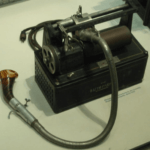Shorthand Stenography Online Course Chapter 5 “Material Required for Writing Shorthand”
Material Required for Writing Shorthand
For a skilled subject like shorthand, proper choice of material is essential. The list of material and equipment can vary from situation to situation.
(a) Pen or Pencil : Any good quality pen with a nib, not too stiff, can be used for writing shorthand. Such a pen should be used exclusively for writing shorthand. In no case a ball point pen should be used for writing shorthand. You can use either pen or pencil, especially available for writing shorthand.
(b) Shorthand Notebook : Only ruled paper is used for writing Pitmans system of shorthand. Standard size ruled shorthand notebooks of the size 12 cms. x 19 cms. are commonly available in the market, which should be used for writing shorthand. When writing shorthand, only the front side of the leaf should be used, leaving the back side. When the whole notebook has been used, it should be reversed, to enable you to write on the other side of the various leaves of the notebook.
(c) Printed Lessons containing Exercises or Textbooks : As you have to practice from the exercises given in these lessons and also from other text material at a later stage, these should be readily available when writing shorthand.
(d) Furniture and layout: You should use an armless chair, approximately 40-45 cms. high depending on your height. For writing shorthand you should prefer an office table (approximately of the height of 70-75 cms.) You should also make sure that the room in which you write shorthand, particularly when you are transcribing from dictation, should be free from noise. There should be sufficient lighting in the room, so that the thin shorthand outlines can be read easily.
(e) Dictation Equipment : Dictation Machines, Dictaphones are used by some officers when the services of Stenographers are not available, such as, beyond office hours, at homes or holidays, for the purpose of dictating correspondence or any other matter. These machines record human voices (dictated matter) on suitable media, such as, plastic tape, plastic disc, plastic belt, coated paper, wire etc. Shown below is the photo of dictaphone.
The Stenographer or audio-typist plays back the recording on any desired speed, listens to it (usually through headphones) and types what he/she hears. Some modern transcribing units incorporate foot or hand controls for starting and stopping the machine, voice control adjustments (to regulate speed, volume and tone), a backspacer for repeating dictation, and a signalling device to indicate the length of dictation and places where corrections have been made. You should be conversant with the operation of the recording machines such as dictaphones, computers etc. the situation can arise when you may have to use one in any office.























